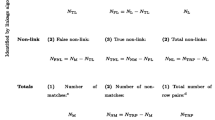Abstract
To assess the validity of probabilistic linkage (PL) in combining national surveillance data on assisted reproductive technology (ART) with Massachusetts birth and infant death data, for the purpose of monitoring maternal and child health outcomes of ART. A study conducted in 2006 utilized direct identifiers to match Massachusetts birth records with records on ART procedures performed to Massachusetts residents in fertility clinics located in Massachusetts and Rhode Island, achieving a linkage rate of 87.5%. The present study employed PL using the program Link Plus, without access to direct identifiers. The primary linking variables were maternal and infant dates of birth, and plurality. Ancillary variables such as maternal ZIP code and gravidity helped resolve duplicate matches and capture additional matches. PL linked 5,390 (87.8%) of 6,139 deliveries, correctly identifying 96.4% of the matches previously obtained using deterministic linkage methods. PL yielded a high linkage rate with satisfactory validity; this method may be applied in other states to help monitor the maternal and child health outcomes of ART.
Similar content being viewed by others
References
Centers for Disease Control, Prevention. (2010). American Society for Reproductive Medicine, Society for Assisted Reproductive Technology. 2008 Assisted reproductive technology success rate. Atlanta, GA: Centers for Disease Control and Prevention.
Centers for Disease Control, Prevention. (1997). American Society for Reproductive Medicine, Society for Assisted Reproductive Technology. 1995 Assisted reproductive technology success rate. Atlanta, GA: Centers for Disease Control and Prevention.
Reynolds, M. A., Schieve, L. A., Martin, J. A., Jeng, G., & Macaluso, M. (2003). Trends in multiple births conceived using assisted reproductive technology, United States, 1997–2000. Pediatrics, 111, 1159–1162.
European Society of Human Reproduction and Embryology (ESHRE) Capri Workshop Group. (2000). Multiple gestation pregnancy. Human Reproduction, 15, 1856–1864.
Martin, J. A., & Menacker, F. (2007). Expanded health data from the new birth certificate, 2004. National Vital Statistics Reports, 55(12), 1–22.
Zhang, Z., Macaluso, M., Cohen, B., Schieve, L. A., Nannini, A., Chen, M., et al., for the Massachusetts Consortium for Assisted Reproductive Technology Epidemiologic Research (MCARTER). (2009). Accuracy of assisted reproductive technology information on the Massachusetts birth certificate, 1997–2000. Fertility and Sterility, in press.
Sunderam, S., Schieve, L. A., Cohen, B., Zhang, Z., Jeng, G., Reynolds, M. A., et al., Massachusetts Consortium for the Assisted Reproductive Technology Epidemiologic Research (MCARTER). (2006). Linking birth and infant death records with assisted reproductive technology data: Massachusetts, 1997–1998. Maternal and Child Health Journal, 10, 115–125.
Schieve, L. A., Cohen, B., Nannini, A., Ferre, C., Reynolds, M., Zhang, Z., et al., for the Massachusetts Consortium for Assisted Reproductive Technology Epidemiologic Research (MCARTER). (2007). A population-based study of maternal and perinatal outcomes associated with assisted reproductive technology in Massachusetts. Maternal and Child Health Journal, 11, 517–525.
Korzeniewski, S. J., Grigorescu, V., Copeland, G., Gu, G., Thoburn, K. K., Rogers, J. D., et al. (2010). Methodological innovations in data gathering: newborn screening linkage with live births records, Michigan, 1/2007–3/2008. Maternal and Child Health Journal, 14(3), 360–364.
Johnson, J. C., Soliman, A. S., Tadgerson, D., Copeland, G. E., Seefeld, D. A., Pingatore, N. L., et al. (2009). Tribal linkage and race data quality for American Indians in a state cancer registry. The American Journal of Preventive Medicine, 36, 549–554.
Fellegi, I. P., & Sunter, A. B. (1969). A theory for record linkage. Journal of the American Statistical Association, 64, 1183–1210.
Piper, J. M., Mitchel, E. F., Jr, Snowden, M., Hall, C., Adams, M., & Taylor, P. (1993). Validation of 1989 Tennessee birth certificates using maternal and newborn hospital records. American Journal of Epidemiology, 137(7), 758–768.
Campbell, K. M., Deck, D., & Krupski, A. (2008). Record linkage software in the public domain: A comparison of Link Plus, The Link King, and a ‘basic’ deterministic algorithm. Health Informatics Journal, 14, 5–15.
Grigorescu, V., Zhang, Y., Macaluso, M., Durant, T. (2010). Differences in pregnancy outcomes of assisted reproductive technology by infertility diagnosis Michigan, 2000–2004. December 2010. 16th Annual MCH EPI conference, San Antonio, TX, USA.
Westphal, L., Grigorescu, V., Sappenfield, W., Freeman, K. (2010). Maternal demographic characteristics for the Florida assisted reproductive technology-vital records linked file. December 2010. 16th Annual MCH EPI conference, San Antonio, TX, USA.
Cohen, B., Macaluso, M., Molotnikov, L., Sappenfield, W., Silver, M., West, J., Westphal, L., Zhang, Y. (2010). Can birth certificate data be used to assess assisted reproductive technology (the Florida and Massachusetts experience)? December 2010. 16th Annual MCH EPI conference, San Antonio, TX, USA.
Acknowledgments
The authors thank Massachusetts Department of Public Health for their support of birth and infant death data and the Society for Assisted Reproductive Technology (SART) and the American Society for Reproductive Medicine (ASRM) for their support of ART data, their contributions are essential to the completion of the research.
Conflict of interest
None.
Author information
Authors and Affiliations
Corresponding author
Additional information
Disclaimer : The findings and conclusions in this report are those of the authors and do not necessarily represent the official position of the Centers for Disease Control and Prevention.
Rights and permissions
About this article
Cite this article
Zhang, Y., Cohen, B., Macaluso, M. et al. Probabilistic Linkage of Assisted Reproductive Technology Information with Vital Records, Massachusetts 1997–2000. Matern Child Health J 16, 1703–1708 (2012). https://doi.org/10.1007/s10995-011-0877-7
Published:
Issue Date:
DOI: https://doi.org/10.1007/s10995-011-0877-7




